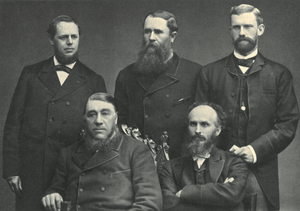Nicolaas Smit
Nicolaas Jacobus Smit (5 May 1837 – 4 April 1896) was a Boer general and politician. During the First Boer War, he led Boer force to victory during the Battle of Majuba Hill. He was elected Vice State President of the South African Republic after the elections of 1888 and he served until his death.[1]
Nicolaas Jacobus Smit | |
|---|---|
.png) | |
| Born | 30 May 1837 Doornbos, South Africa |
| Died | 4 April 1896 (aged 58) Pretoria, South Africa |
| Allegiance | |
| Service/ | military |
| Years of service | 1860-90 |
| Rank | Generaal |
| Commands held | Transvaal Commandos |
| Battles/wars | Ingogo Heights; Majuba Hill. |
| Awards | from Portugal, Netherland, and Prussia. |
| Relations | Nicolaas Van der Merwe |
| Other work | Vice State President of the South African Republic 1888-1896 |
Early life
The son of Nicolaas Jacobus Smit (1811-1887) and Elizabeth Magdalena Van der Merwe (1815-1892), the young Nicolaas was born at Doornbos, near Graaf Reinet. The family could trace their descent from the first Dutch Calvinist settlers who arrived at The Cape before 1688, the Van der Merwe and De klerk families were among the very first white settlers on the continent. Aged twenty-five he to Natal with his parents. They lived at Durban for a while, but disliked the English society. Nicolaas decided to join the army, which he eventually achieved by going into the veldt with a group of comrades.
Later life
Smit settled on a farm with his family in 1873 on the Sheepmor, a little to the west, in the eastern Transvaal over the Modder River in a region in traditional conflict over land rights with the Zulu tribes. Farming at Goedehoop he first came into contact with the Swazi tribesmen. By then he had been promoted to a lieutenant-general in the Boer kommando taking the battle to Pedi under Chief Sekhukane, who had been sent to ally the tribe with the Boer Republic.[2] On 5 July achieved higher status acquiring a lease of a head of cattle in the Ngwenya Hills, north-west of Forbes Reef. Smit proved an adept commander of mobile units of Veldt horsemen or kommando. At the Battle of Ingogo Heights, an inferior force of only 200 managed to force three times as strong in atrocious weather conditions. General Colley withdrew into the darkness leaving 96 British dead. By contrast the Boers lost only 8 men.
In January 1881 Colley was ambushed by a Boer force at Laing's Nek, in a series of battle in which he was outmanoeuvred by the local farmer-irregulars. The circumstance leading up to the British disaster at Battle of Majuba Hill were indicative of a lack of understanding and knowledge of the landscape and conditions in which the Boers fought. Colley was unprepared and made a number of errors making defeat more likely. But Smit showed bold and courageous leadership attacking up hill in the teeth of enemy fire using the contours in the land for their own protection. Their khaki colours merged into the background, and their knowledge of the open country prevented the British from seeing their targets. They had failed to dig in or protect their lines by trenches, which had been normal military procedure since the Crimean wars of 1850s. Moreover the British had not brought artillery with their baggage trains, making defence of such a hill top position exposed on several flanks. The Boers made full use of the multi-sided attacks on their enemy to confuse and intimidate the inexperienced British regulars. Unable to hold the line they broke after the Boers had captured the right flanking position at Gordon's Knoll. General Smit's victory brought the Transvaal War to a swift conclusion. It enabled a Boer Republic to be established at the Pretoria Convention in the Transvaal which went unchallenged until the Second Boer War. For example by 1883, the British contingent had dropped to 7100 soldiers, permitting Boer incursions into Bechuanaland in flagrant breach of the convention. But as far as the Boers believed it, the London Convention (1884), which superseded the Pretoria Convention and to which Smit was a signatory, ceded suzerainty to them for all time.[3]
For his courage and presence of mind on the battlefield, Nicolaas Smit earned the gratitude of his people, who offered him political office as a reward. A senior cabinet-level politician he did not live to see the declaration of Independence by President Kruger.
Marriage
He married Hendrika Stephina (1841-1894), daughter of Hendrik Stephanus Pretorius and Rachel Jacoba Liebenberg at Rustenburg in April 1863. They had three sons and two daughters. In May 1895 he married again, a widow, Sussana Bosman.
Awards
- Knight of the Red Eagle - Prussia
- Commander of the Order of the Lion - Netherlands
- Portugal
Gallery
 The Boer Delegates 1883-1884
The Boer Delegates 1883-1884
.png)
References
- http://hdl.handle.net/10394/14081 Die ontstaan en ontwikkeling van die amp van die staatspresident in die Zuid-Afrikaansche Republiek, 1858-1902, "Du Plessis_JS_Chapter11.pdf" (2.125Mb)
- H M Jones, Bibliographical Register of Swaziland to 1902
- Boberts, Salisbury, p.247-8